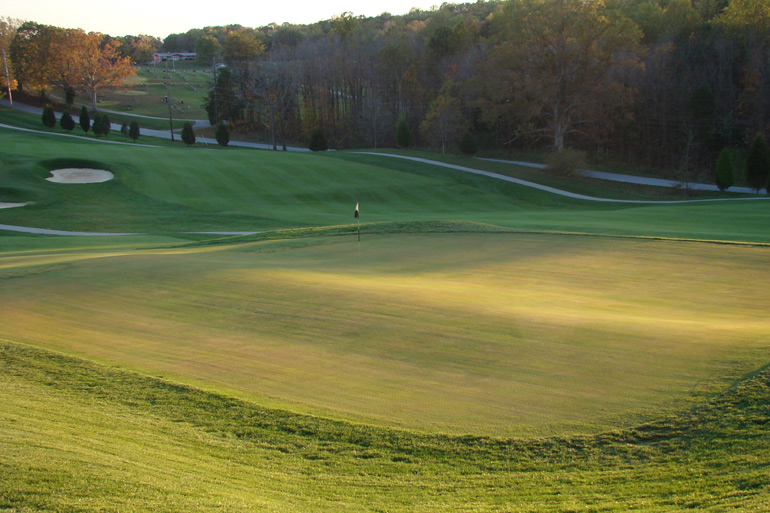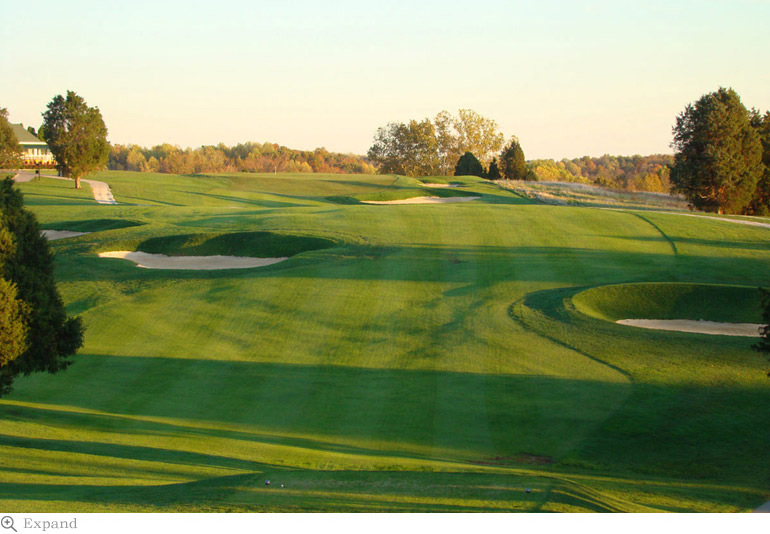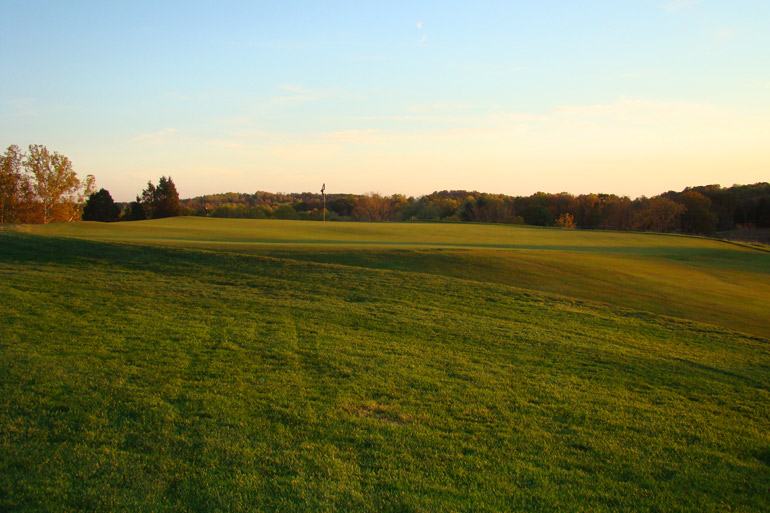French Lick Resort (Ross Course)
Indiana, United States of America
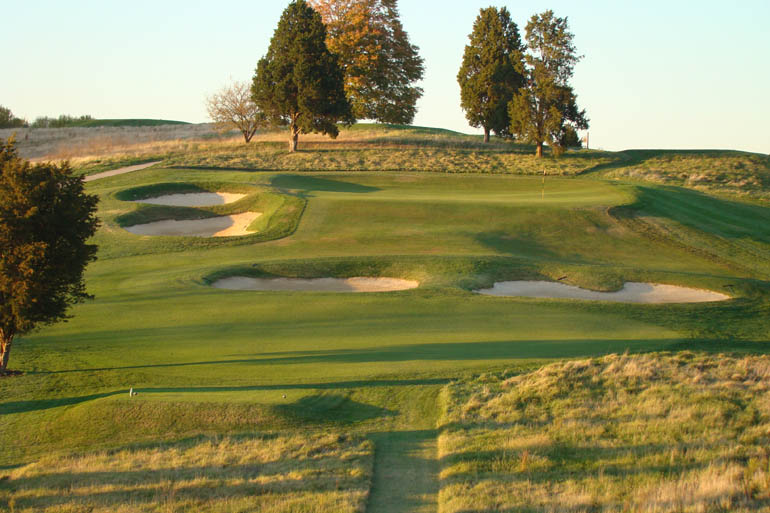
Though full of the design features that make Golden Age courses a delight to play, the Ross Course at the French Lick Resort also requires stout hitting, as evidenced by the 240 yard fourth hole above.
The Donald Ross Course at the French Lick Resort in southern Indiana highlights the design genius of Donald Ross as well as most of his more famous courses that were built for private clubs. All the key design elements are found here: Good terrain, an exemplary routing, broad fairway corridors, well placed bunkers to lend the open holes their playing strategy, and a wonderful set of varied greens that remain largely untouched.
Situated amid rolling land, Ross’s talent for routing is much in evidence with the tees and greens occupying the high spots. What is especially impressive is how Ross connected all the holes without a weak or filler hole in the bunch, all the while preserving short green to tee walks. Like many of his courses with nines that return to the clubhouse, the first and tenth holes parallel each other and then head off to form a loop in the opposite direction (other examples include Seminole, Mountain Ridge, Plainfield and Mark Twain). This routing works well as the direction of play constantly changes, an important consideration given how there is generally some breeze about on this elevated piece of Indiana countryside some 600 feet above sea level.
The greens have always been the star feature. Unlike his greens at Pinehurst No. 2 where the primary goal is just to get on them, these greens are characterized by tremendous interior undulations. Averaging almost 6,000 square feet, they are ample targets but ala St. Andrews, just hitting them is only the beginning. Get above the hole on such greens as the first or eighth, or be on the wrong tier such as on the thirteenth or seventeenth, or find yourself on the wrong side of a spine such as at the eleventh or eighteenth, and you have all but guaranteed at least one extra stroke.
Prior to Lee Schimdt’s 2006 restoration, these two components – Ross’s fine routing combined with these famous greens – defined the course. Working in close concert with The Donald Ross Society and its Executive Director Michael Fay, Schimdt’s work re-introduced a vital third element, namely effective bunkers. To be precise, thirty-six bunkers were re-introduced with the most important ones being central hazards that had been long ago removed. Prior to 2006, the golfer was free to swing out from the tee with little concern. Twenty-nine fairway bunkers were restored including a dominant one on the inside of the dogleg left eighth and important center line ones on the second, third, fifth, seventh, fifteenth, and eighteenth holes. Coupled with the club’s new fescue grassing scheme, the player now needs to focus on placing his ball properly off the tee.

Looking across the first fairway at the wicked eighth green with its six foot drop from back to front.
Two things have mercifully never changed here. One is that that the course has never had a tree problem and it retains an open air quality to this day. As a result, many magical long views are afforded across the course’s interior. Also, this course was built as a means to attract patrons to the French Lick Resort; it was never built for the purpose of selling homes around its perimeter. A game here is one played in solitude, free from outside disturbances as we shall see below.
Holes to Note
First hole, 420/400 yards; This is a rare hole where the splendid view from the tee is complimented by the design of the hole. Like many of Ross’s best openers (e.g. Salem, Oak Hill, Mid Pines) this one plays downhill to a generous landing area. Not only is the golfer inspired by the vista but the visitor can also quickly determine that the ideal line of play is down the left of the fairway. True of all Ross’s best work, the challenge stiffens at the green which features a severe slope from back-left to front-right. Nonetheless, play usually gets off to a smooth start, always an important consideration for an opening hole, be it a public or private course. Ross opined that a starting hole in the 400 yard range was preferable and this one fits the bill nicely.
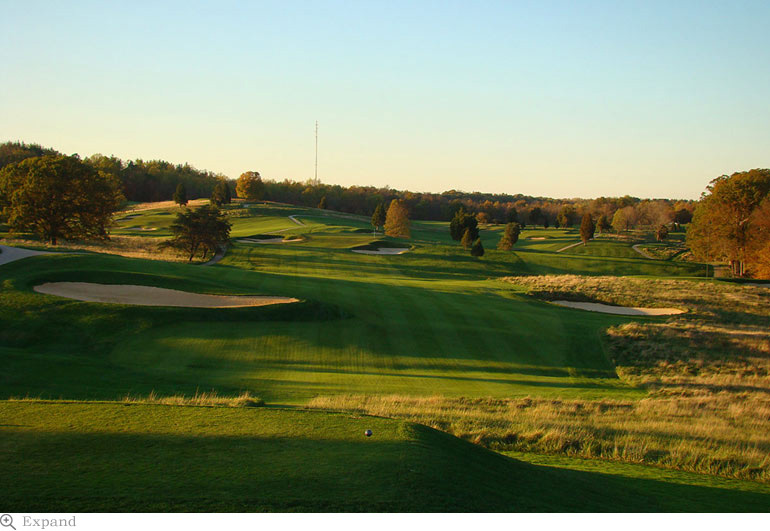
The view from the first tee of the Ross Course at French Lick surely counts among the more enticing prospects in world golf.
Second hole, 420/380 yards; Of all the bunkers restored to Ross’s design by Schmidt, none caused the locals to gnash their teeth more than the pair of central hazards that were re-introduced into the second fairway. Given their prominent location (i.e.directly in the line of play!), it is little wonder that they had been removed in the 1950s. As Ross noted in the must-read Golf Has Never Failed Me, ‘Often, the highest recommendation of a bunker is when it is criticized. That shows that it is accomplishing the one thing for which it was built: It is making players think.’
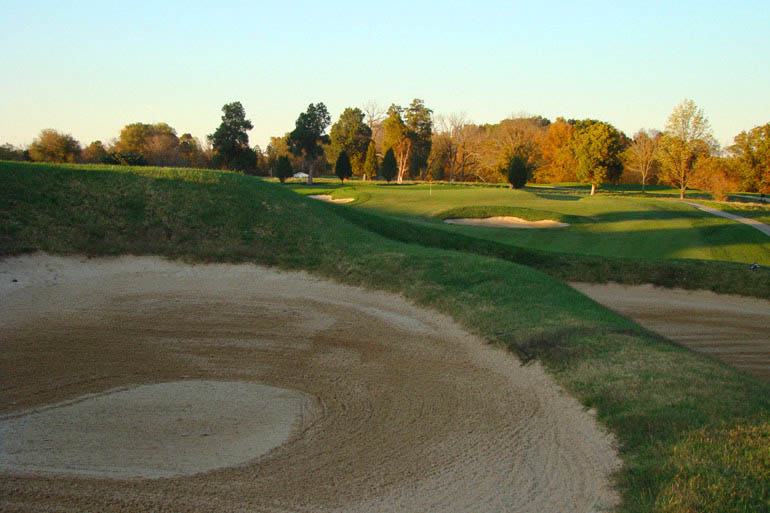
In 2005, it was clear sailing down the middle of the second fairway. Today, golfers need to weigh the advantage of carrying these central hazards in order to enjoy the best angle into the green.
Third hole, 425/405 yards; Any good routing gives the player a sense of property and its virtues. Already by the third tee, the player has gained an appreciation of the rolling topography upon which Ross layed out the course in 1916.
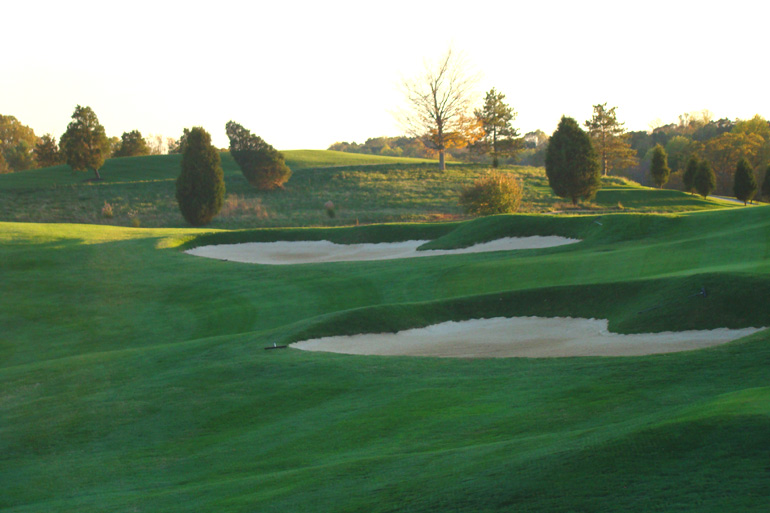
A tee ball that carries past these two bunkers and over the hill enjoys a big kick forward down the fairway.
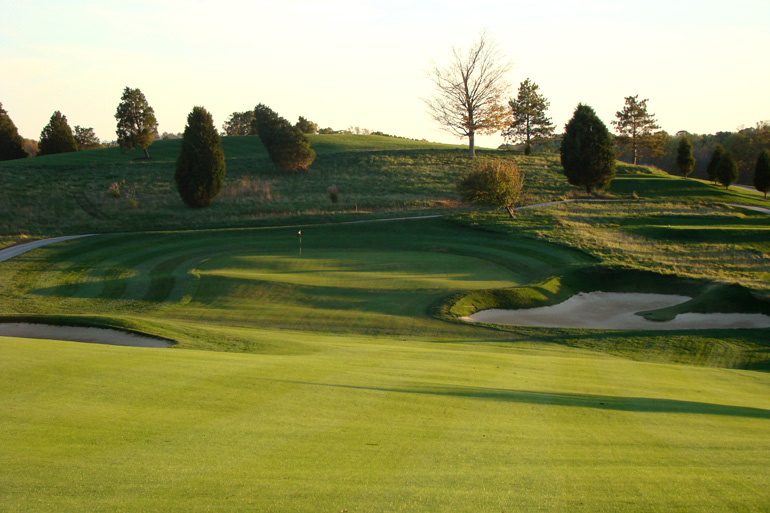
Once over the crest of the hill, this glorious view unfolds of the third green complex. The mammoth right greenside bunker is perfectly in scale with the sweep of the surrounding land. Anything smaller risked looking puny against its environment.
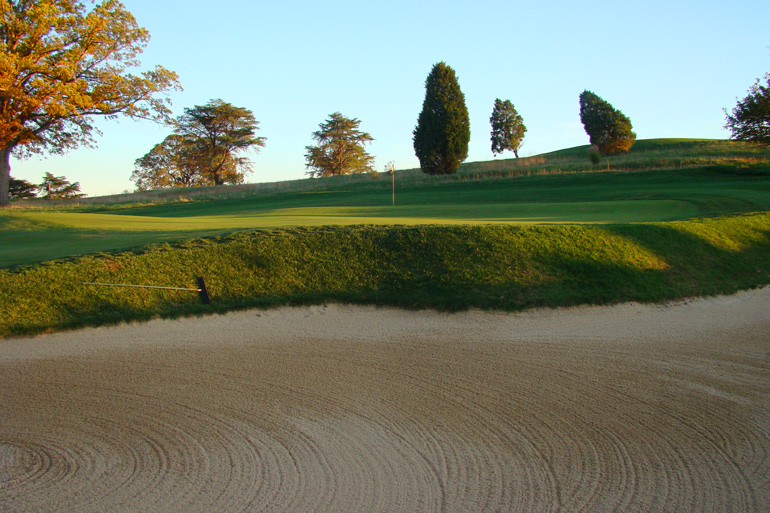
Benched into the hillside, it is no surprise to find that the third green is steeply pitched from back to front.
Fourth hole, 240/195 yards; The collection of one shot holes at the Ross Course should be heralded as among the best set that Ross ever designed. Going further, who can dismiss them as one of the standout sets in world golf? This one plays across a valley and there is a real sense of accomplishment – and relief – in seeing a tee ball land on the distant plateau green. Otherwise, a wide variety of recovery shots await, generally with only the flag visible as the golfer is likely to be well below the putting surface.

The scary part of this long one shotter? Its the shortest of the first three par threes and its green features the tamest contours. Take heart!
Fifth hole, 475/460 yards; Ross had a fondness for big holes of any par, and this is the first such two shotter at French Lick. From the tee on top of the hill, the hole drops and runs straight away along the top of the ridge with drop-offs on both sides. From here until the fourteenth tee, the golfer gets to see his ball land and bound along the fairway courtesy of Ross’s elevated tees and artful routing.

The ground falls away off either side of this fairway which Ross shrewdly laid atop a ridge line. The large bunker that juts into the fairway is 150 yards from the green and wasn’t there in 2005.

Though a veteran of golf course constrcution for over twenty years, Schmidt had never previously restored a Ross course. As evidenced by this bunker to the right of the fifth fairway, he was a quick study in making the bunkers look like they belonged on a Ross course in rural Indiana.
Sixth hole, 250/210 yards; A lesser designer might have left the player with the feeling that the property was too severe given its never ending rolls. However, not Ross as he uses the long one shotters to give the player essentially level (though dramatic) shots over some of the steepest banks on the property. One wonders what came first: Was it Ross’s discovery of the hog back that became the fifth fairway with this hole then becoming the logical sequel? Or did Ross locate the herioc sixth first and then work backwards to find the fifth? Either way yielded the same result which is distinctive golf of a very high order.
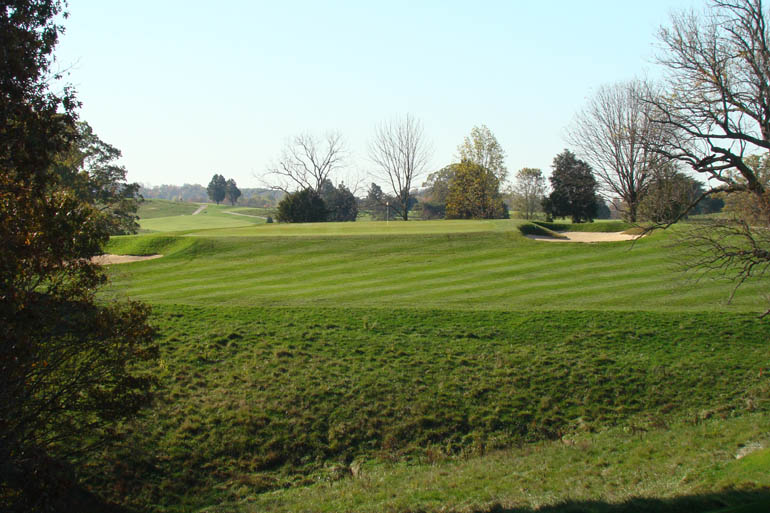
Hard as it is to imagine, each of the first three par threes gets successively harder. At the sixth, it is a ravine instead of a valley and the green features more slope than at the fourth.
Eighth hole, 390/370 yards; Ross did not design an abundance of dog-leg holes, as some modern architects are wont to do but this is one, featuring a sharp turn to the left. What distinguishes this hole is the tension created by a deep grass ravine and the steeply pitched back to front green just beyond it. An old course guide writes that the eighth is ‘one of the most talked about holes in Indiana golf’ – and rightly so! At one point the green dropped seven and one-half feet from the back to the front; today it is a mere six feet! Of course, today’s green speeds make it feel even more severe. Worse, the golfer frequently finds himself above forward hole locations because of the influence of the perilous ravine fronting the green. In Golf Has Never Failed Me, Ross wrote, ‘Deep grass ravines are truly a delightful type of hazard’ and ‘I lose no opportunity to use them in every posssible way.’ One can only imagine how the players performed on this infamous hole during the 1924 PGA Championship won by Walter Hagen.
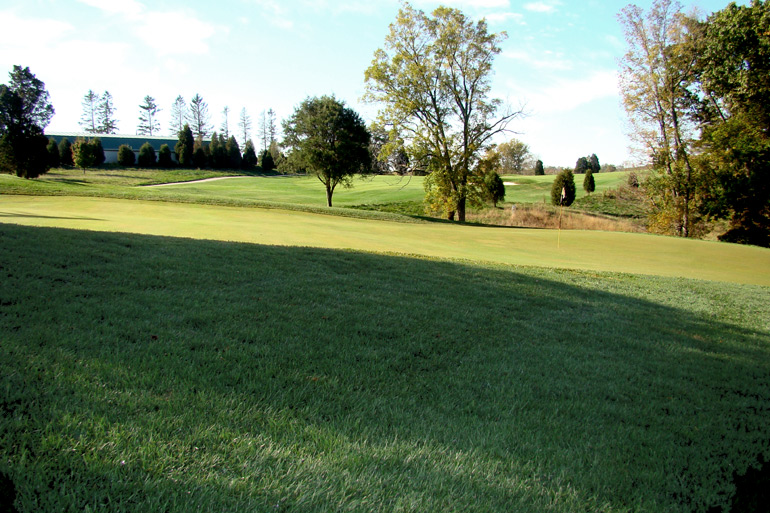
This view from the left of the eighth green gives a sense of the green’s dramatic drop from back to front.
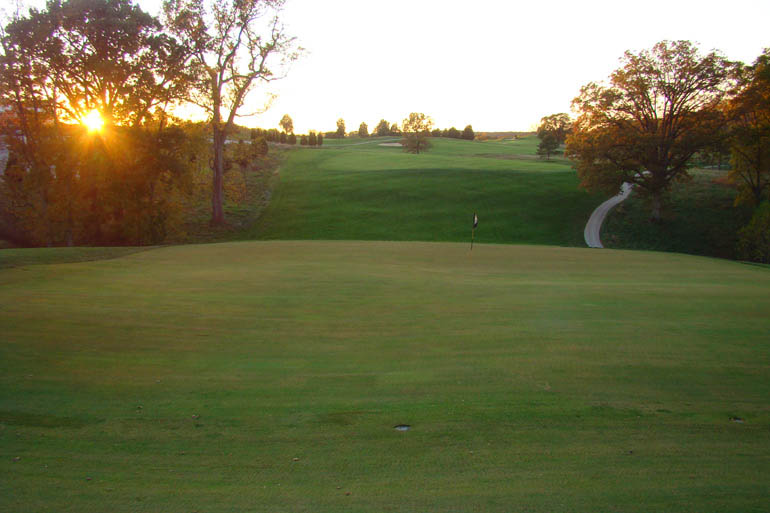
This view from behind the green captures both its size (it is the largest on the course at 7,502 square feet) and slope (hard to hide six feet of drop!).
Tenth hole, 390/375 yards; Ross was so proficient at using topography maps that he famously never visited nearly half of the 400 courses that bear his name in North America. However, French Lick is one example in the Midwest where Ross spent time on site. How and where his personal attention effected the in-the-dirt final design is impossible to say. Look at this marvelous pulpit green pad below. Did Ross himself direct its construction or did his on-site construction foreman Sandy Alves push it up that extra bit, hoping for Ross’s approval? Impossible to know and assigning credit to that degree is a fool’s game. All that matters is the final product and this pulpit green is an architectural gem. Humourously, the old green keeper once grumbled words to the effect that,’We would have the course built and Ross would come along and ruin it.’
 Though Ross located the tenth green on a high spot, Alves and he also significantly built up the green pad. Despite running parallel with the first hole, the two holes enjoy markedly different playing characteristics because of their varied green complexes.
Though Ross located the tenth green on a high spot, Alves and he also significantly built up the green pad. Despite running parallel with the first hole, the two holes enjoy markedly different playing characteristics because of their varied green complexes.
Eleventh hole, 365/345 yards; Placing a tee on high is an easy step for an architect as he knows that most players will appreciate the commanding view down the length of a hole. However, how an architect elects to handle upslopes is a trickier proposition. Do nothing and the golfer is left with the impression of an uphill slug. Over do it and uphill holes quickly become too difficult for the majority of players. Ross struck a perfect balance here at the eleventh where his bunker scheme visually breaks up the far hillside in an appealing manner. In addition, he keep the length of the hole modest, making an allowance for the fact that the fairway plays up one of the more abrupt slopes on the property.
 The placement of the bunkers works beautifully in conjunction with the fairway slopes. A draw at the right bunker hits hard and feeds off the right to left slope into the perfect position for a pitch. Even from the tee, the golfer gains a sense of the heavily contoured putting surface.
The placement of the bunkers works beautifully in conjunction with the fairway slopes. A draw at the right bunker hits hard and feeds off the right to left slope into the perfect position for a pitch. Even from the tee, the golfer gains a sense of the heavily contoured putting surface.
Twelfth hole, 435/430 yards; Topography imbues a golf hole with all sorts of unique playing characteristics but often those characteristics change with time. In Ross’s day, the player was pleased if he could find the flat portion along the left side of the fairway some 175 yards from the green. Today, the tiger is frustrated at having to lay back off the tee but the sloping fairway narrows considerably starting around the 300 yard mark from the back tee.
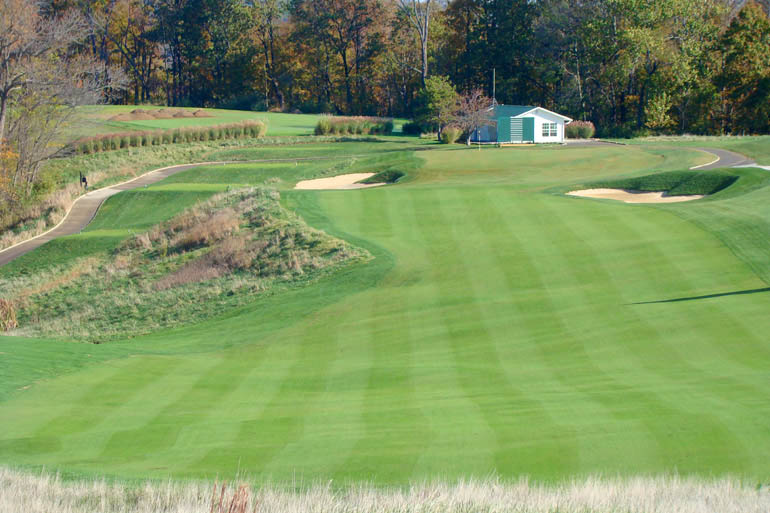
A nice flat area some 175 yards from the green down the left of the fairway provides both a fine stance and angle from which to approach the green. Those with greedier ambitions forever fight the right to left slope.
Thirteenth hole, 250/230 yards; What terror a resort guest with a hickory driver in his hand must have felt in 1920 when the hole measured 230 yards. Played across a steep valley, the tee shot is most certainly alarming yet the golfer is also inspired as Ross gives the golfer plenty of room to operate. Importantly, save for a topped shot, the golfer will finish the hole with the same ball with which he began, a design trait that is sadly absent on many showcase holes on modern courses. One of the deepest bunkers on the course is well short of the green with plenty of short grass between it and the green. Not feeling constrained, the golfer may even surprise himself and make a confident swing, sending the ball onto the tri-level (!) green. Why would Ross build such a fiendish green on such a long hole? Just imagine a bland oval green in its place and you have your answer!
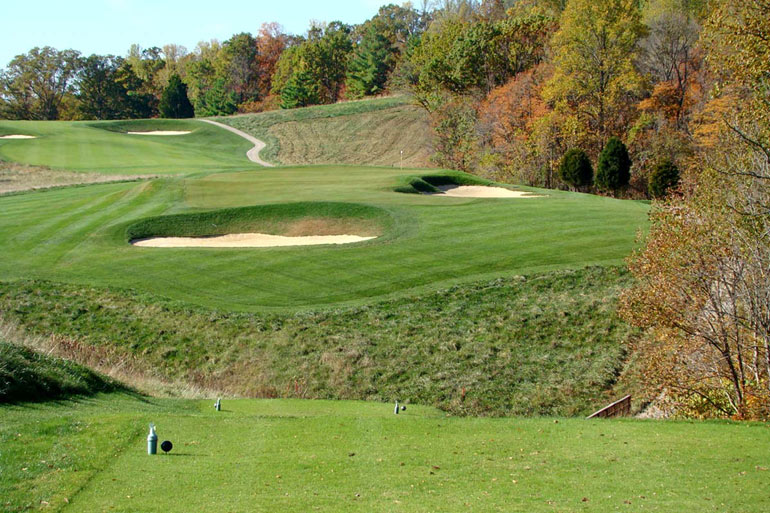
One great aspects of Schmidt’s work is how the scale of the bunkers once again matches the scale of the property/holes. The cavernous bunker that was recaptured forty yards short of the putting surface is a prime example.
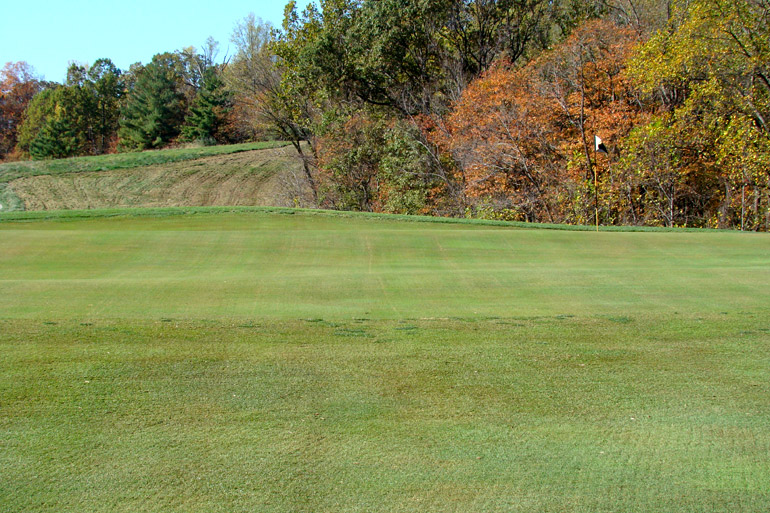
Each segment of this three-level green seems shockingly shallow, but it works here since each also has a backstop. In fact, the top level is a bowl.
Fifteenth hole, 665/530 yards; The only fundamental changes to Ross’s holes occured at the fourteenth and fifteenth during the early 1970s when the club established an irrigation pond. As the two shotter fourteenth plays now, this pond serves as a handsome backdrop to a short iron approach. In Ross’s day, the green was another 150 yards ahead and the hole was a long three shotter over 600 yards in length. The fifteenth was a three shotter too though considerably shorter. Today, the tee for the fifteenth is back behind the irrigation pond and this attractive fairway meanders past cross bunkers before reaching a well conceived green complex.

The long fifteenth is capped off by this old-fashioned L shaped bunker that wraps around the green’s back left corner.
Sixteenth hole, 150/135 yards; Measured from the back markers, this hole is the shortest one shotter on the course by 90 yards – think about that! Surrounded by a circle of bunkers, the heavily contoured green calls for an appealing yet precise shot and wonderfully complements the bruisers that come before it. Like the sixteenth at Royal North Devon, the sixteenth at Riviera and the seventeenth at Sand Hills, it demonstrates that length isn’t a pre-requisite for a course’s final one shotter.
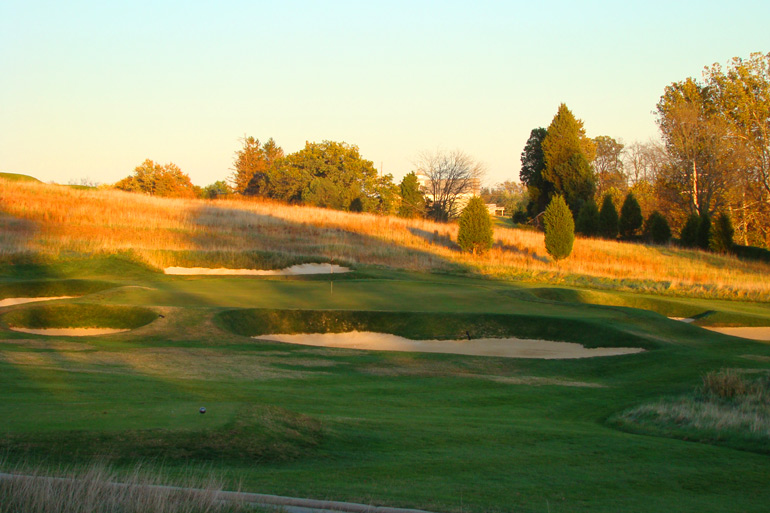
A virtual island green in a sea of sand, the sixteenth is the most tightly defended green on the course.

The desire to stay below the day’s hole location on this steeply pitched back to front green often times leaves the golfer with this recovery shot from the front bunker.
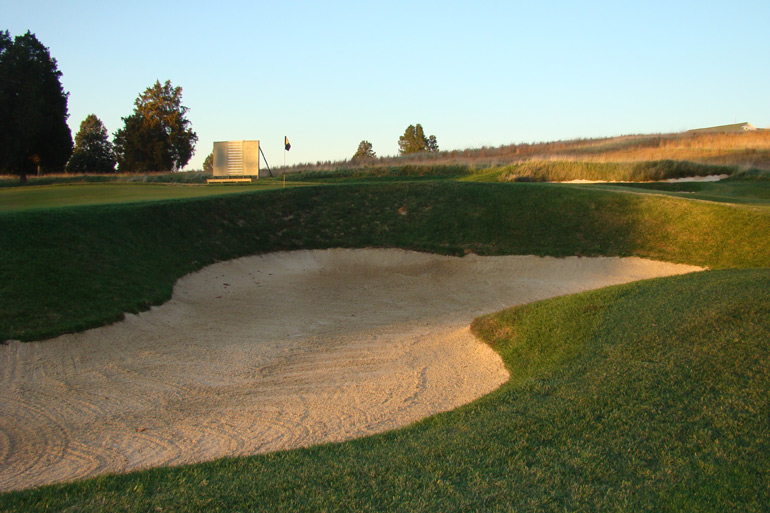
Even more problematic is a recovery from the deeper right greenside bunker.
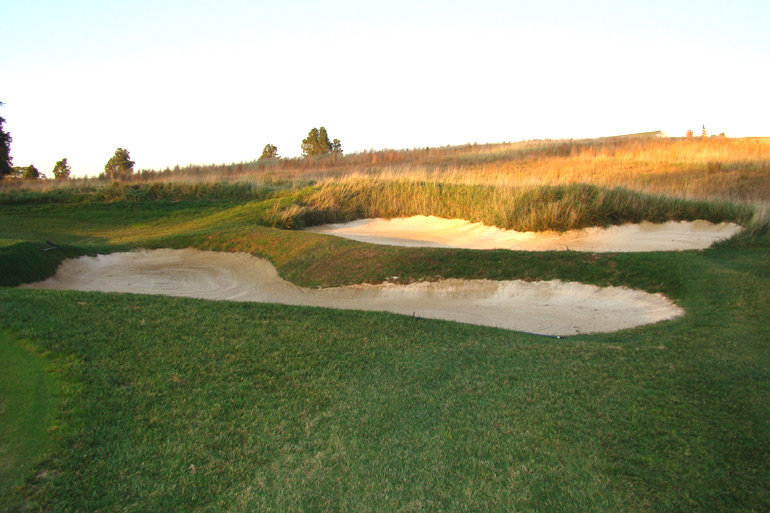
Originating with the ninth hole at Essex County outside of Boston, Ross deployed double bunkers from time to time. These two located behind the green are another example.
Seventeenth hole, 380/360 yards; This hole plays shorter than its modest length as a hill 200 yards out adds thirty yards to the drive. The right side of the green is four feet higher than the left and exemplifies the fun and challenge of severe greens. If the hole is to the right (the difficult location), the player can have a reasonable chance at a three with only the most exact of approaches. Otherwise, he will have to work hard to earn a four. If the hole is on the lower left, the player can use the slope that bisects the two sides of the green to funnel his ball toward the hole. When the hole is positioned on the right, the severity of the green hurts the player. When on the left, it aids him. Though audacious, the green contours work well together and allows the green overall to function well as a single unit.
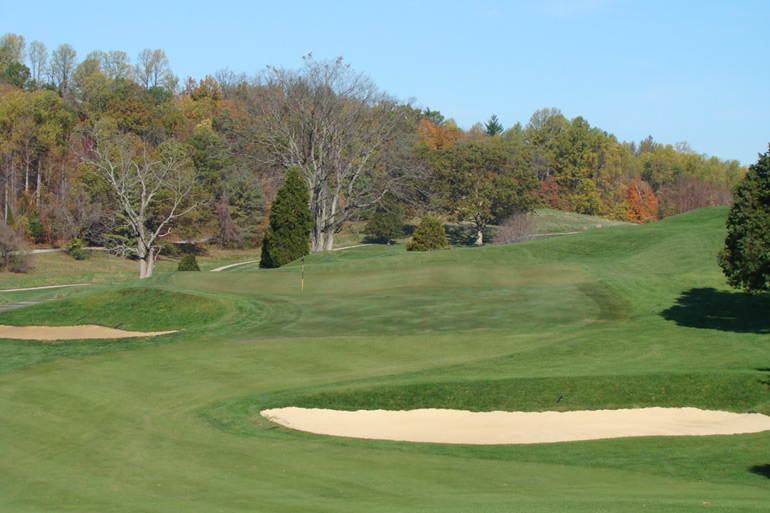
Courtesy of an astonishing green, the seventeenth is a memorable penultimate hole despite its modest length.
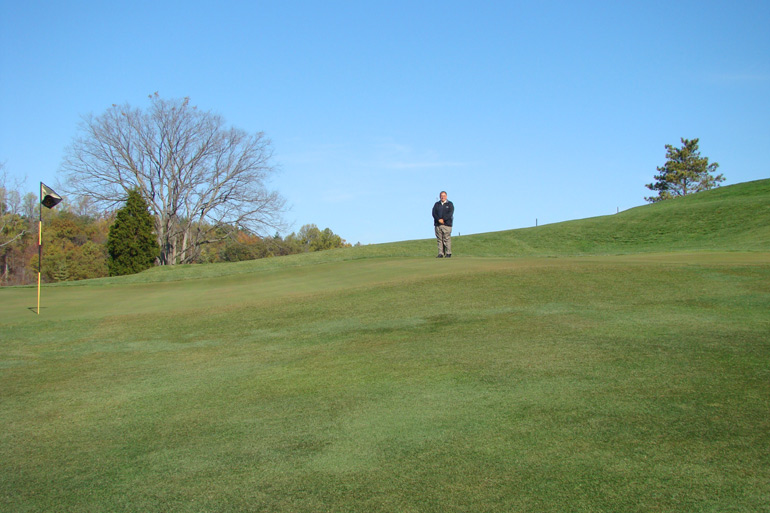
One gains an appreciation of the difference in height of the right half of the green versus the left half by looking at Director of Golf Dave Harner’s feet relative to the day’s lower left hole location.
